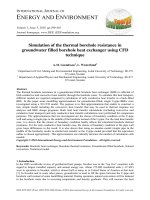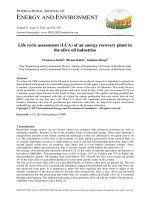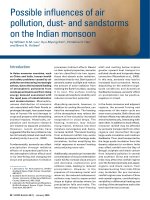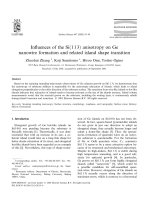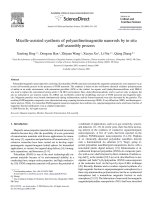Study the influences of the radionuclide depth distributions on the FEPE for the measurements of the soil activity using in situ HPGe gamma spectrometry
Bạn đang xem bản rút gọn của tài liệu. Xem và tải ngay bản đầy đủ của tài liệu tại đây (221.43 KB, 7 trang )
Nuclear Science and Technology, Vol.7, No. 2 (2017), pp. 25-31
Study the influences of the radionuclide depth distributions on
the FEPE for the measurements of the soil activity using in situ
HPGe gamma spectrometry
Truong Thi Hong Loan1,2*, Vu Ngoc Ba1, Le Hung Quoc Dan2,
Truong Huu Ngan Thy1, Huynh Thi Yen Hong1
1
Nuclear Technique Laboratory, VNUHCM - University of Science, Viet Nam.
Faculty of Physics and Engineering Physics, VNUHCM - University of Science, Viet Nam
Email:
2
(Received 01 Octorber 2017, accepted 25 Octorber 2017)
Abstract: In this work, the influences of the soil densities and the radionuclide depth distributions
(RDD) on the Full Energy Peak Efficiency (FEPE) calculation of the in-situ gamma ray
spectrometer using the In Situ Object Counting Systems (ISOCS) software were studied. The data of
the RDDs at the sites were investigated by using laboratory HPGe gamma spectrometer. Six different
RDDs of 40K, 226Ra and 232Th were found at four studied sites with radionuclide deposition moving
from surface to deeper positions. The results show that FEPE values vary strongly for the different
RDDs, especially for the low gamma ray energies. Use of the uniform model for calculating FEPEs can
result in noticeable errors from 29% to 101% for the realistic RDD of the exponential form (surface
radionuclide deposition), negative variations from 14% to 30% for the realistic RDD of having a
radionuclide deposition at the 30 cm depth, and negligible variations of less than 5 % for the realistic
RDD of quasi uniform form in the range of gamma ray energies of interest.
Keywords: HPGe gamma spetrometer, radionuclide depth distributions, full energy peak efficiency.
I. INTRODUCTION
In-situ gamma ray spectrometry using
a HPGe detector is an effective method to
determine natural and artificial radionuclide
concentration
in
geophysical
field,
assessment of doses due to radioactive
fallout or pollutants as well as estimation of
soil erosion [1] [2]. It allows the direct and
quick
qualitative
and
quantitative
determination of gamma emitting radioactive
pollutants. The advantages of this method
involve obtaining prompt available results
about the average activity of radionuclides
over large area [3]. On the contrary, the
main disadvantage of the method is that the
accuracy and the precision of the analysis
results strongly depend on the radionuclide
depth distribution within the soil [4,5].
In this work we study in details the
influence of soil density and the radionuclide
depth distribution on the FEPE s of the in-situ
gamma ray spectrometer using the ISOCS
software [6]. The RDD of 238U, 232Th and 40K at
the survey areas are estimated by laboratory
HPGe gamma spectrometer using the LabSOCS
software [7]. First of all, some measurement
conditions for in-situ gamma ray spectrometer
are studied using the ISOCS software.
II. SUBJECTS AND METHOD
A. Introduction to ISOCS and its characteristics
The In Situ Object Counting Systems
(ISOCS) was developed by Canberra Industries,
Inc. It involves the coaxial p-type HPGe
detector of GC2518, standard acquisition
electronics, shielding, collimators, detector
carrier and detector stand (Figure 1).
©2017 Vietnam Atomic Energy Society and Vietnam Atomic Energy Institute
STUDY THE INFLUENCES OF THE RADIONUCLIDE DEPTH DISTRIBUTIONS ON THE FEPE
Fig. 1. In situ object counting system (ISOCS) using
HPGe of GC2518 detector.
Fig. 2. Laboratory gamma spectrometry using HPGe
of GC3520 detector.
The ISOCS/LabSOCS software is used
for calibrating the HPGedetector efficiency as a
function of energy for over a photon energy
range of 45 keV through 7 MeV, for a wide
variety of source geometries and activity
distributions that could be encountered in insitu measurements (ISOCS) and laboratory
measurements (LabSOCS) for environmental
analysis [7].
GC3520 (Figure 2), with count times set to 24
hours. The FEPEs of the laboratory detector
were calibrated by using LabSOCS software.
In this study, the detector was located at
1 m above the ground surface, with its
collimator opening angle of 900, the view of the
detector covers a soil column of 2 m diameter.
This selected set-up may be expected to reduce
the influences of radioactivity background from
plants or buildings, walls surrounding the
surveyed locations.
- UNI model uses the uniform density
and radionuclide depth distribution. The soil
density and its activity were averaged over the
whole of the interested soil column of 200 cm x
30 cm (see Table I). The surveyed soils are
alluvial with the composition of Dirt 1 [8].
- DEN model uses the same averaged
activity as UNI model but its density varies
with layer depth (Table 5). Each layer has 200
cm diameter and thickness of 3 cm. The soil
composition is of Dirt 1 for grey soil at the
above 12 cm layer and of Dirt 4 for the red soil
at the rest depth layer [8].
- RAD model takes into account for
radionuclide depth distribution, but the soil
density is averaged over the whole of the
interested soil column of 200 cm x 30 cm. The
soil composition is of Dirt 1 and Dirt 4 [8].
- DEN-RAD model takes in account for
both density and radionuclide depth
C. Models of density and radionuclide depth
distribution
The following four models of density and
RDD were proposed for studying the influence
of RDD on the FEPEs:
B. Sampling in depths and laboratory
measurements
At four sites of the in-situ measurements,
four soil cores were collected. The core tube
was inserted vertically to sample soil in depth
up to 30 cm. Each core was sectioned into 3 cm
increments to provide more detailed
information on the RDD of these radionuclides.
The samples from the sectioned core were
dried, ground and analyzed in the laboratory
using high resolution HPGe gamma detector of
26
TRUONG THI HONG LOAN et al.
distributions. Its density and activity are
averaged for each 3 cm layer (Table 5). The soil
composition is of Dirt 1 and Dirt 4 [8].
surface was explained by soils in these areas
has been often fertilized for planting [9].
Potasium is easy to dissolve. Watering and
rainfall can make them penetrate into the deeper
layer of the soil and form a distribution of the
activity in the soil decreasing exponentially
with depth. By the time, the position of the
maximum of the radionuclide distribution in
soil can move from the surface to deeper
positions make it may be approximated by
Lorentz distribution as in case of 40K at the site
3 (B type) and of 40K at the site 1 (C type). In
another case, 40K and 226Ra at the site 4 has
quasi uniform distribution (D and E type
respectively) because of the physical, chemical
and biological nature of the soil, the climate,
streaming and human interventions [10]. In the
meanwhile, primordial radionuclides of 232Th at
the site 1 which have an increase of activity to
the 30 cm depth (F type) was explained by
wash out of 232Th in soil for a long time.
After inputting these parameters in
ISOCS, FEPEs for gamma ray energies from
the natural radionuclides in soils and fallout
137
Cs were calculated for four models combined
with six typical depth profiles of density and
radionuclide based on the laboratory HPGe
gamma measurements. The comparisons of
FEPE – energy curves from the different
models with the realistic DEN-RAD models
were studied and discussed.
III. RESULTS AND DISSCUSION
A. The radionuclide depth distribution using
laboratory measurements
The depth distribution of 40K, 226Ra and
232
Th in four soil cores collected at the areas of
Thu Duc, Ho Chi Minh city, Viet Nam were
investigated by using laboratory HPGe
spectrometry.
The
results
show
that
radioactivity distributions are functions of soil
depths in an exponential form, a quasi Lorentz
distribution, a quasi uniform distribution, and a
linearly activity increase to the 30 cm depth
(Figure 3). In details, the RDD of 40K at site 2
(A type) having an exponential form with its
maximum activity of 74 Bq/kg at the ground
B. The influence of the different realistic
radionuclide depth distribution on FEPEs
Six
typical
radionuclide
depth
distributions obtained from laboratory
measurements which were selected to study
their influences on FEPE in the range of
gamma ray energies of interest were
presented in Figure 3.
B
Soil depth (cm)
Soil depth (cm)
A
3-6
9-12
15-18
21-24
27-30
3-6
9-12
15-18
21-24
27-30
0
20
Activity of
40
40K
60
0
80
20
Activity of
(Bq/kg) at site 2
27
40
40K
60
(Bq/kg) at site 3
80
STUDY THE INFLUENCES OF THE RADIONUCLIDE DEPTH DISTRIBUTIONS ON THE FEPE
D
3-6
Soil depth (cm)
Soil depth (cm)
C
3-6
9-12
15-18
21-24
9-12
15-18
21-24
27-30
27-30
0
0
40
80
120
Activity of 40K(Bq/kg) at site 1
10
Soil depth (cm)
Soil depth (cm)
F
3-6
9-12
15-18
21-24
27-30
5
Activity of
30
Activity of 40K (Bq/kg) at site 4
E
0
20
10
226Ra
15
3-6
9-12
15-18
21-24
27-30
20
0
(Bq/kg) at site 4
20
40
60
Activity of 232Th (Bq/kg) at site 1
Fig. 3. The radionuclide distributions of 232Th, 226Ra, 40K as a function of depth estimated by laboratory HPGe
spectrometer (spectroscopy) for the in-situ surveyed sites.
The percentages of the activity at each 3
cm layer relative to the sum of the activities of
the whole soil core of 30 cm depth were
calculated from data of the laboratory HPGe
gamma measurements at section B.2 and given
in Table I. These percentages with the
collected data of density depth profile
respectively were used to input in the
Geometry Composer interface of ISOCS. The
data of the whole soil column of 30 cm depth
at the surveyed sites are listed in the final row
of the Table I.
Table I. The densities (D) and the percentages of activities (PA) in depth y (cm) for six RDDs
RDD
A Type
B Type
C Type
D Type
E Type
F Type
y
(cm)
D
(g/cm3)
PA
(%)
D
(g/cm3)
PA
(%)
D
(g/cm3)
PA
(%)
D
(g/cm3)
PA
(%)
D
(g/cm3)
PA
(%)
D
(g/cm3)
PA
(%)
0-3
1.66
0.22
1.32
0.13
1.51
0.08
1.02
0.11
1.02
0.09
1.51
0.07
3-6
2.00
0.13
1.81
0.18
2.07
0.12
1.58
0.10
1.58
0.09
2.07
0.08
6-9
2.23
0.09
1.81
0.09
1.47
0.14
1.58
0.10
1.58
0.09
1.47
0.09
9-12
2.41
0.10
1.89
0.11
1.47
0.19
1.58
0.10
1.58
0.10
1.47
0.08
12-15
1.92
0.07
1.85
0.08
2.30
0.18
1.47
0.13
1.47
0.10
2.30
0.10
15-18
2.11
0.09
1.92
0.07
2.30
0.07
1.70
0.11
1.70
0.10
2.30
0.11
28
TRUONG THI HONG LOAN et al.
18-21
2.00
0.07
2.34
0.07
2.75
0.06
1.74
0.05
1.74
0.10
2.75
0.11
21-24
2.04
0.07
1.58
0.09
2.15
0.05
1.66
0.11
1.66
0.11
2.15
0.11
24-27
2.19
0.08
1.70
0.08
2.68
0.06
1.77
0.10
1.77
0.11
2.68
0.12
27-30
1.96
0.08
2.45
0.09
2.41
0.05
2.30
0.09
2.30
0.11
2.41
0.13
0-30
2.05
1.00
1.87
1.00
2.11
1.00
1.64
1.00
1.64
1 .00
2.11
1.00
Figure 4 illustrates ratios of FEPEs
computed by the different models to FEPEs
computed by the realistic DEN-RAD model for
six typical RDDs and in the range of interested
gamma ray energies. The results show
remarkable variations of relative FEPE values
based on the UNI and DEN models, especially
for the low gamma ray energies. The negative
deviations were found mainly for FEPEs of the
UNI model compared with FEPEs of the DENRAD model of A, B, C type which has the
maximum activity of radionuclide deposition
lies from the ground surface to a half of a 30 cm
depth. The positive deviations were found
mainly for FEPEs from UNI model compared
with DEN-RAD model of E, F type which has
the maximum activity at the bottom (30cm
depth). In the meanwhile, the negligible
deviations of FEPEs were found for FEPEs of
UNI model compared with FEPEs of DEN,
RAD, and DEN-RAD models of D type. Figure
6 also indicates that there is negligible variation
between FEPEs of UNI model and FEPEs of
In details, FEPE-energy curve obtains the
highest values for the DEN-RAD of A type and
the lowest values for the DEN-RAD model of F
type. FEPE values vary strongly for the
different RDDs, especially for the low gamma
ray energies. In calculating FEPEs, using the
uniform model instead of the realistic RDD can
result in noticeable errors from 29 % to 101 %
for the exponential form, negative deviations
from 14 % to 30 % for radionuclide deposition
at the 30 cm depth, negative or positive
variations from 2 % to 21 % for the quasi
Lorentz form.
A
1.00
0.80
0.60
0.40
0.00
500.00 1000.00 1500.00 2000.00 2500.00 3000.00
UNI
E(keV)
DEN
RAD
B
1.20
Relative FEPE
1.20
Relative FEPE
DEN model or FEPEs of DEN-RAD model and
FEPEs of DEN model because densities of the
layers do not much change. Besides, in the
histograms of A, B, F in Figure 3 and Figure 4
it seems that the more radioactivity the more
negative or positive deviation of FEPEs when
UNI model was used instead of the realistic
DEN-RAD models.
1.00
0.80
0.60
0.40
0
1000
UNI
DEN-RAD
29
E (keV)
DEN
2000
RAD
3000
DEN-RAD
STUDY THE INFLUENCES OF THE RADIONUCLIDE DEPTH DISTRIBUTIONS ON THE FEPE
C
D
1.20
1.00
Relative FEPE
Relative FEPE
1.20
0.80
0.60
1.00
0.80
0.60
0.40
0.40
0
500
1000
1500
2000
2500
0
3000
1000
DEN
UNI
DEN-RAD
E
1.30
1.10
0.90
0.70
0
1000
2000
DEN
RAD
RAD
DEN-RAD
1.30
1.10
0.90
0.70
3000
0
E (keV)
UNI
DEN
F
1.50
Relative FEPE
1.50
Relative FEPE
RAD
3000
E (keV)
E (keV)
UNI
2000
DEN-RAD
UNI
1000
2000
3000
E (keV)
DEN
RAD
DEN-RAD
Fig. 4. The ratios of FEPEs (relative FEPE) for the different models to the realistic DEN-RAD model with
gamma ray energies from 63.83 keV to 2614.51 keV for six typical RDDs.
the depth sampling and using laboratory
measurements to obtain the radionuclide depth
distribution at the surveyed site is still an
selected manner for having a more accurate
quantification of the soil activity.
IV. CONCLUSIONS
The calculated FEPEs vary strongly for
the different realistic models of radionuclide
depth distribution, such as exponential form,
quasi Lorentz distribution, quasi uniform, or
deeper depositions. The surface deposition can
result in more errors of FEPEs (with a positive
deviation of 70% for gamma ray energies less
than 238 keV) than the radionuclide deposition
at a 30 cm depth (with negative deviation of
25% for energies higher than 238 keV
respectively) using the uniform radionuclide
depth distribution model for calculating FEPEs.
Although the knowledge of the site history, the
properties as well as the origin of radionuclides
within soils can help predict an appropriate
model of the radionuclide depth distribution,
ACKNOWLEDGEMENTS
This study is funded by Vietnam
National University of Ho Chi Minh City under
Grant Number B2017-18-01.
REFERENCES
[1] Alvarez, A, Corea, E, Navarro, N, Sancho,
C.“Uranium determination in samples from
decommissioning of nuclear facilities, related
to the first stage of the nuclear fuel
cycle”,Applied Radiation and Isotopes, 53, 355
– 359, 2000.
30
TRUONG THI HONG LOAN et al.
[6] Canberra, Inc.“Nuclear Measurement Solutions
for Safety, Security and the Environment –
Technical Reference Manual V4.3, Model S573
ISOCS Calibration Software”, Canberra
Industries Inc, 2012.
[2] Tyler, A.N, Sanderson, D.C.W, Scott, E.M.
“Estimating and accounting for 137Cs source
burial through in situ gamma spectrometry in
salt
marsh
environment”,Journal
of
Environmental Radioactivity, 33, 195 – 212,
1996.
[7] Canberra,
Inc.
“Nuclear
Measurement
Solutions for Safety, Security and the
Environment – Validation and Verification
Manual, Model S573/S574 ISOCS/LabSOCS”,
Canberra Industries Inc, 2002.
[3] Li J, Li Y, Wang Y, Wu J. “Applicability of
using in situ gamma ray spectrometry technique
for 137Cs and 210Pbex inventories measurement
in grassland environments”, Applied Radiation
and Isotopes, 68, 1143 – 1149, 2010.
[8] Canberra, Inc. “Genie 2000 3.3. Customization
Tools Manual”, Canberra Industries Inc, 2013.
[4] Lettner H, Andrasi A, Hubmer A.K, Lovranich
E, Steger F, Zombori P. “In situ gamma
spectrometry intercomparison exercise in
Salzburg, Austria”,Nuclear Instruments and
Methods in Physics, Research A 369, 547 –
551, 1996.
[9] Thummerer S, Jacob P. “Determination of
depth distributions of natural radionuclides with
in situ gamma ray spectrometry”,Nuclear
Instruments and Methods in Physics Research
A 416, 161 – 178, 1998.
[5] Font S.H, Alvarez J.L. “Data quality objectives
for surface soil cleanup operation using in situ
gamma
spectrometry for concentration
measurements”,Health Physics 72 (2), 286 –
295, 1997.
[10] Laedermann J.P, ByrdeF, Murith C. “In situ
Gamma ray Spectrometry: the Influence of
Topography on the Accuracy of Activity
Determination”,Journal of Environmental
Radioactivity, 38 (1), 1 –16, 1998.
31

